There is no doubt that snakes can be some of the scariest animals on the planet. Thankfully, most of the snake species across the world are totally harmless and don’t really care much to mess with humans. Even if they wanted to, most snakes are much too small to really threaten a human.
Still, there are some species of snake out there that are so large that most people would be shocked at just how large a kill they can eat. Today, we are going to be exploring just that: what is the largest animal a snake can eat? The answer may surprise you!
What is the largest animal ever eaten by a snake?
The largest recorded animal eaten by a snake was a 150 lb hyena that was swallowed by an African rock python in 2017. National Geographic caught the encounter on video and was able to film the 12-foot-10-inch snake coiled around the animal as it began to swallow.
Previously, the largest animal to ever be eaten by a snake was a 130 lb impala eaten by an African rock python back in 1955.
Viewer warning: African rock python eating a hyena
There is a lot of speculation as to the largest animal that a snake can eat! Currently, the record is held by a rock python in Africa that killed and ate an adult hyena weighing 150 lbs.
Although big cats and hyenas are often considered to be predators of these snakes, rock pythons will occasionally consume cubs if given the chance. The video of the snake swallowing the hyena prompted scientists to consider the fact that rock pythons are more capable of hunting dangerous prey than they had originally thought.
While this hyena may be the largest animal eaten on record, that doesn’t mean there aren’t undocumented examples of larger animals that have been consumed by pythons.
In general, these snakes do make meals of cattle and deer, with a record of a Burmese python in Florida swallowing a 35 lb deer in 2018. Who knows when the current record will be beaten? And there are also two reported cases of a reticulated python killing and consuming a human.
Rock pythons are some of the largest snakes in the world, and they are known to eat some pretty large animals. Although these snakes are truly massive, they aren’t the only species to go after prey as large as they are.
Let’s explore some of the other snakes across the world and see what the largest animals they can eat are!
Which species of snakes regularly eats the largest animals?
The largest snakes in the world are all constrictors, meaning they kill their prey by squeezing them. In order to squeeze large prey, the snakes must be large themselves. As such, the largest snakes in the world are the African rock python, the green anaconda, the reticulated python, the Burmese python, the Indian python, and the amethystine python.
Together, these snakes contend for the top spot as the largest snakes in the world and often grow to incredible lengths and weights.
Here are the common foods that each of these snakes is known to eat.
African rock python
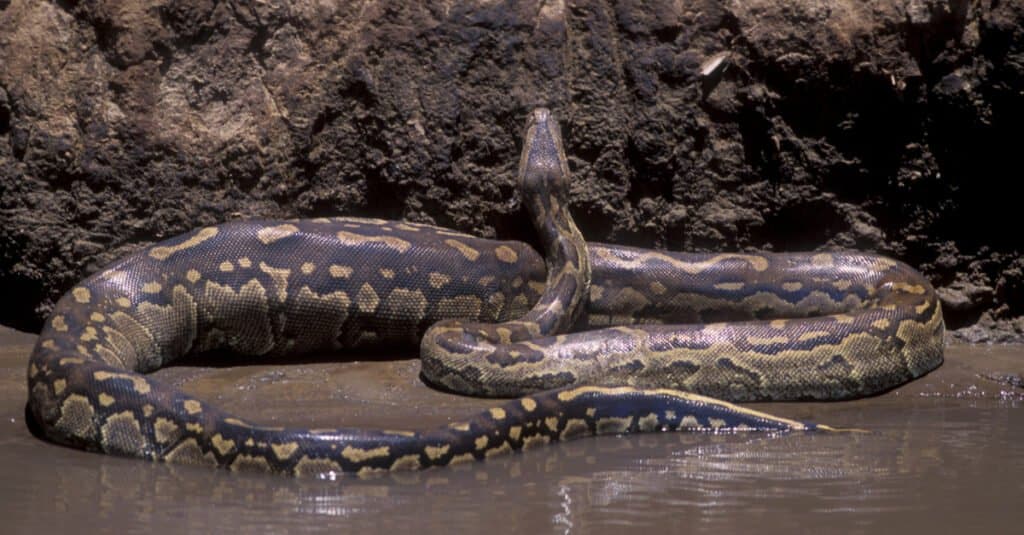
African rock pythons hold the record for the largest meal consumed by a snake.
©zaferkizilkaya/Shutterstock.com
The African rock python is found across all of sub-Saharan Africa and is known as one of the largest snakes in the world. Additionally, this snake holds the current record for the largest recorded meal of any snake, coming in at 150 lbs.
The African rock python regularly eats:
- monkeys
- warthogs
- antelopes
- vultures
- crocodiles
- dogs
- goats
Green anaconda
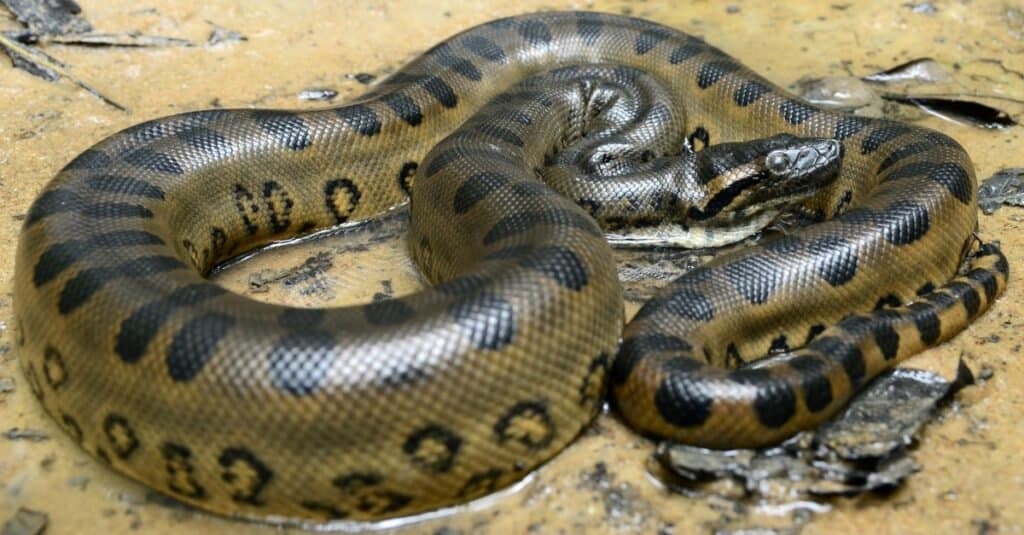
Green anacondas are the heaviest snake in the world and are often considered the largest.
©Patrick K. Campbell/Shutterstock.com
The green anaconda is likely the largest snake in the world by weight, often weighing up to 155 lbs (and in some cases potentially much more!). They are native to South America and are found in much of the Amazon rainforest.
The green anaconda eats:
- tapirs
- deer
- capybaras
- caimans
- monkeys
Reticulated python
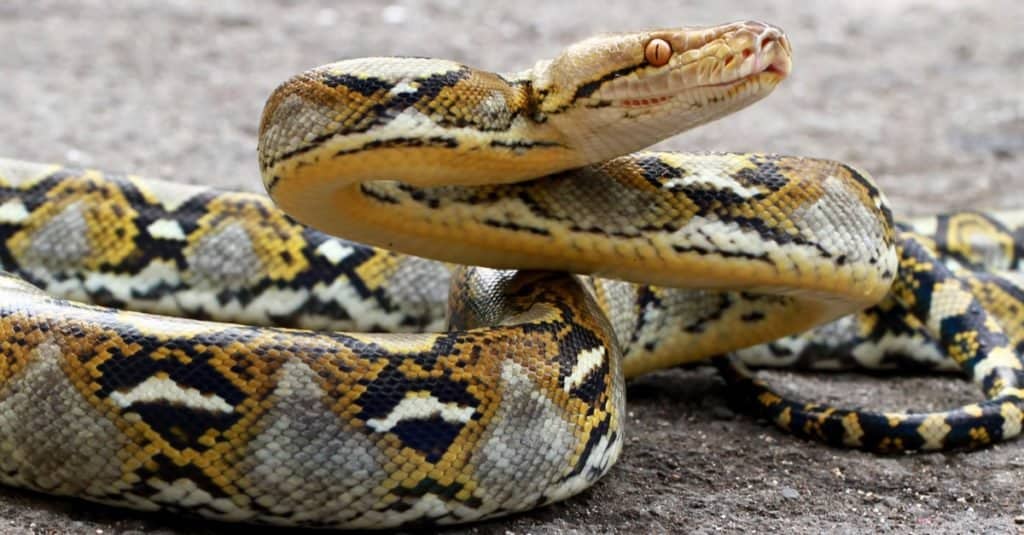
Reticulated pythons are considered the longest snakes in the world.
©Opayaza12/Shutterstock.com
The reticulated python is considered the longest snake in the world and can reach lengths of 21 feet, with some individuals getting even longer.
They are native to Asia, particularly Southeast Asia:
- Indian civets
- binturong
- monkeys
- pigs
- deer
The largest animal eaten by a reticulated python was a half-starved sun bear weighing 50 lbs.
Burmese python
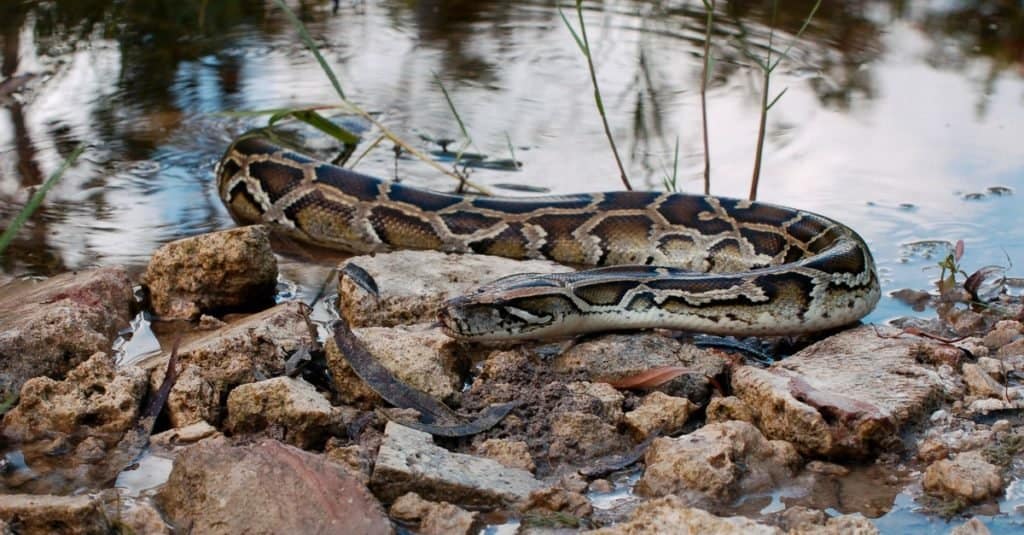
Burmese pythons have become an invasive species in the Florida Everglades.
©Heiko Kiera/Shutterstock.com
The Burmese python is one of the largest snakes in the world and is native to Southeast Asia, India, and Nepal, and is an introduced species in the Florida Everglades.
Burmese pythons eat:
- fox
- rabbits
- raccoons
- pigs
- goats
- deer
- alligators
Indian python
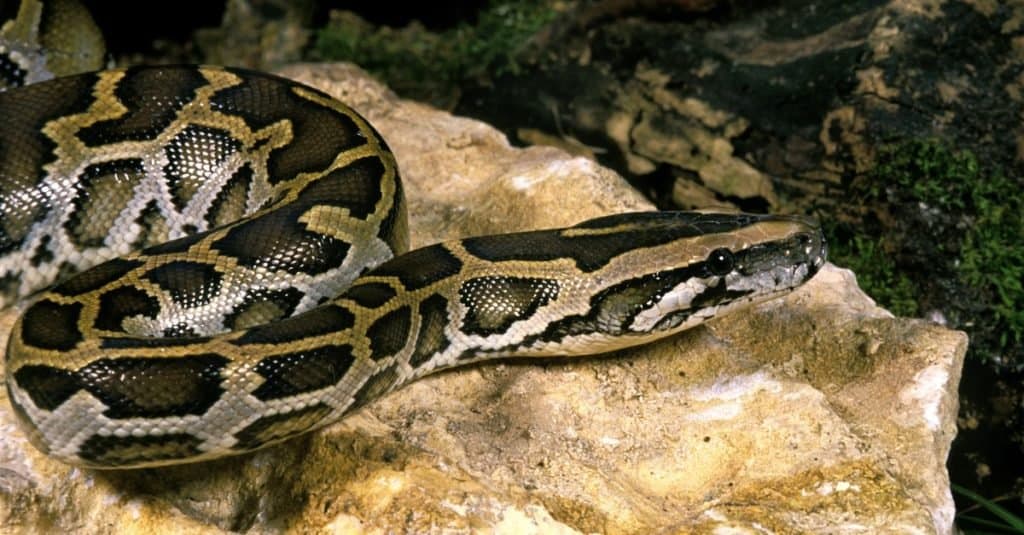
Indian pythons are threatened snakes native to India and the surrounding countries.
©slowmotiongli/Shutterstock.com
The Indian python is another of the largest pythons on earth and is native to India, Nepal, Pakistan, Sri Lanka, Bhutan, and Bangladesh.
Indian pythons are known to eat:
- small to medium-sized mammals
- birds
- other reptiles
Amethystine python
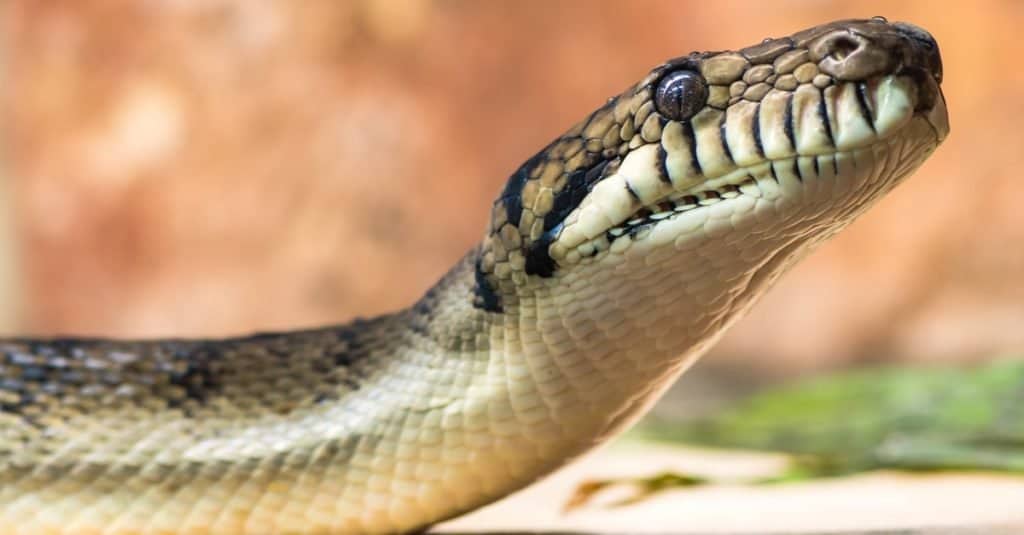
Amethystine Pythons are very good swimmers and will travel by water when it is required.
©IanRedding/Shutterstock.com
The amethystine python is one of the largest snakes in the world by weight and length. They are native to Australia and Papua New Guinea.
The amethystine python eats:
- birds
- bats
- possums
- wallabies
- cuscus
- small deer
How can snakes eat animals that are so large?
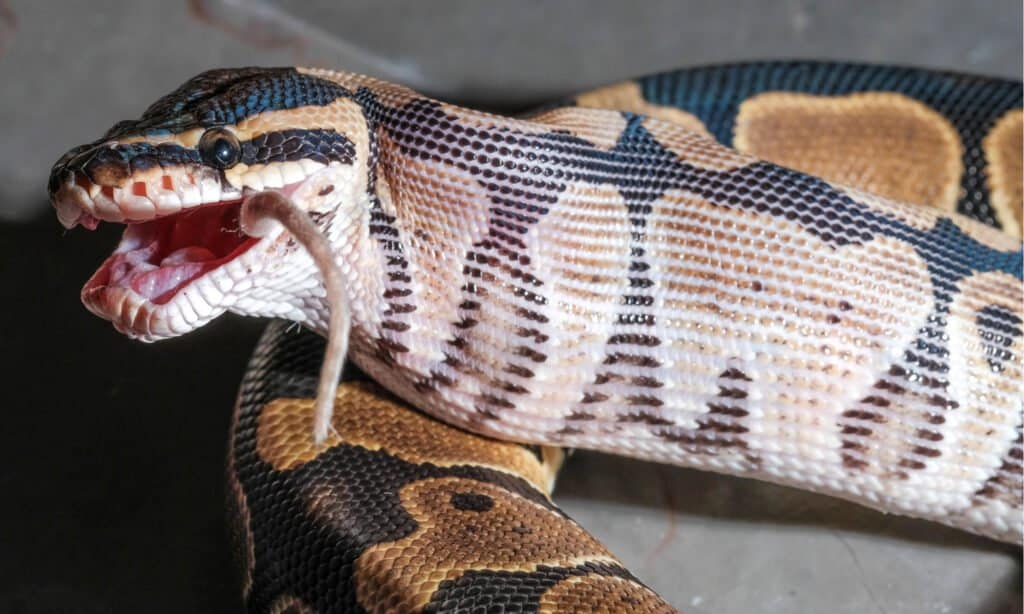
Large snakes eat meals wider than them through their modified jaws and powerful digestive systems.
©Creative Stock Studio/Shutterstock.com
Snakes have a few adaptations that allow them to eat prey that is so much wider than they are. Most of the evolutionary ability that a snake has to swallow large things comes from their lack of limbs and chewing teeth. Without any way to tear or chew their food, finding a way to eat large prey is really important.
The primary evolutionary traits that snakes have to eat massive meals are their jaws, digestive system, and metabolism.
Jaws
Snake jaws are some of the craziest things in the animal kingdom. Part of what makes them special is their lack of a fused jaw. Without a fused jaw (like a human), snakes lose power but gain flexibility. For a snake that doesn’t chew, power isn’t all that important for its jaws. Additionally, the tendons and connective tissue in a snake jaw allow them to open their jaw at 160°, whereas human maxes out at 26°.
Digestion
Once the snake is able to get its food into its stomach through its special jaws, its digestive system kicks into high gear. Their organs shrink to allow more room for the prey to rest in their stomach and relieve pressure. Additionally, their digestive fluids start working and can break down an entire animal, leaving only the hip bones, fur, and hooves. The “extras” are later regurgitated.
Metabolism
Even with a powerful digestive system, it still takes a long time to process. Snakes are cold-blooded, however, and don’t need to eat all the time. When a snake gets a massive meal, it needs a place to rest and break down the prey. If a snake eats a truly huge meal, they are known to find a place to hide and will sit and digest for up to a month straight. Their slow metabolism allows them to sit without moving for the entire time.
Is It Normal for Snakes To Eat Large Animals?
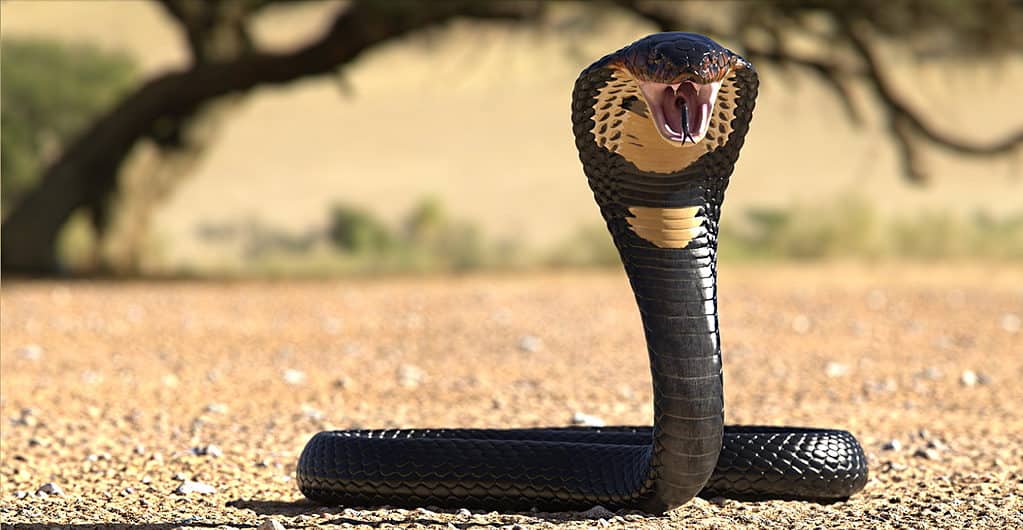
Cobras eat other snakes but will eat birds
©Roberto 33/Shutterstock.com
Yes, it is normal for snakes to eat large animals, as many snake species are capable of consuming prey that is much larger than their own body size.
Snakes are carnivores and have evolved unique adaptations to capture and swallow prey, including the ability to dislocate their jaws and expand their bodies to accommodate large prey.
Some snake species, such as pythons and anacondas, are particularly well-known for their ability to consume large animals like deer, antelope, and even crocodiles.
However, while it is normal for snakes to eat large animals, it is not a common occurrence. Most snakes feed on smaller prey like rodents, birds, and amphibians.
Additionally, the process of consuming large prey can be risky for snakes, as the prey may be able to injure or kill the snake during the struggle. As such, snakes typically only target large prey when it is necessary for their survival.
The photo featured at the top of this post is ©
Discover the "Monster" Snake 5X Bigger than an Anaconda
Every day A-Z Animals sends out some of the most incredible facts in the world from our free newsletter. Want to discover the 10 most beautiful snakes in the world, a "snake island" where you're never more than 3 feet from danger, or a "monster" snake 5X larger than an anaconda? Then sign up right now and you'll start receiving our daily newsletter absolutely free.
FAQs (Frequently Asked Questions)
What is the largest animal a snake has ever eaten?
The largest recorded animal eaten by a snake was a 150 lb hyena that was swallowed by an African rock python in 2017.
Can a snake eat a human?
There are four species of snake that could potentially eat a human, the African rock python, the green anaconda, Burmese pythons, and reticulated pythons. Thankfully, it is rare for a snake to attack a human for food.
What is the largest snake in the world?
The largest snake in the world is split into two categories: weight and length. The heaviest snake in the world is the green anaconda, and the longest snake in the world is the reticulated python.
Thank you for reading! Have some feedback for us? Contact the AZ Animals editorial team.






